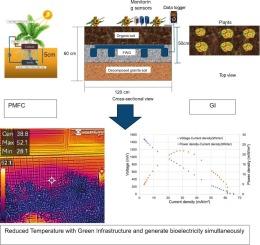Integrating plant microbial fuel cells into green infrastructure: Tackling heat islands and powering sensors
Q1 Environmental Science
引用次数: 0
Abstract
Green Infrastructure (GI) contributes to urban heat island mitigation and aesthetics, yet water supply monitoring remains labor-intensive. This study investigates bioelectricity generation using plant microbial fuel cells (PMFCs) integrated into a GI system constructed with recycled materials. Two GI models (120 × 50 × 60 cm) comprising three 20 cm layers of organic soil, recycled foamed glass (FWG), and decomposed granite were developed. Three PMFCs connecting in series with bamboo charcoal electrodes were embedded in the FWG layer beneath planted vegetation. Voltage was recorded every minute over 20 days and correlated with weather data. Results showed increased bioelectricity during summer driven by solar radiation, while precipitation and temperature had limited influence. In winter, voltage declined after one week. Peak voltage and power densities reached 1800 mV and 23 mW/m2 (winter), and 1400 mV and 11 mW/m2 (summer). Thermographic imaging revealed temperature differences exceeding 20 °C between the GI surface and adjacent concrete, highlighting GI's thermal regulation potential.

将植物微生物燃料电池整合到绿色基础设施中:解决热岛问题并为传感器供电
绿色基础设施(GI)有助于城市热岛缓解和美观,但供水监测仍然是劳动密集型的。本研究研究了将植物微生物燃料电池(pmfc)集成到由回收材料构建的GI系统中的生物发电。开发了两个GI模型(120 × 50 × 60 cm),其中包括三层20 cm的有机土壤,回收泡沫玻璃(FWG)和分解花岗岩。三个pmfc与竹炭电极串联,嵌入种植植被下的FWG层。电压在20天内每分钟记录一次,并与天气数据相关联。结果表明,夏季生物电的增加受太阳辐射的驱动,而降水和温度的影响有限。在冬季,电压在一周后下降。峰值电压和功率密度分别达到1800 mV和23 mW/m2(冬季)和1400 mV和11 mW/m2(夏季)。热成像显示GI表面和相邻混凝土之间的温差超过20°C,突出了GI的热调节潜力。
本文章由计算机程序翻译,如有差异,请以英文原文为准。
求助全文
约1分钟内获得全文
求助全文
来源期刊

Bioresource Technology Reports
Environmental Science-Environmental Engineering
CiteScore
7.20
自引率
0.00%
发文量
390
审稿时长
28 days
 求助内容:
求助内容: 应助结果提醒方式:
应助结果提醒方式:


